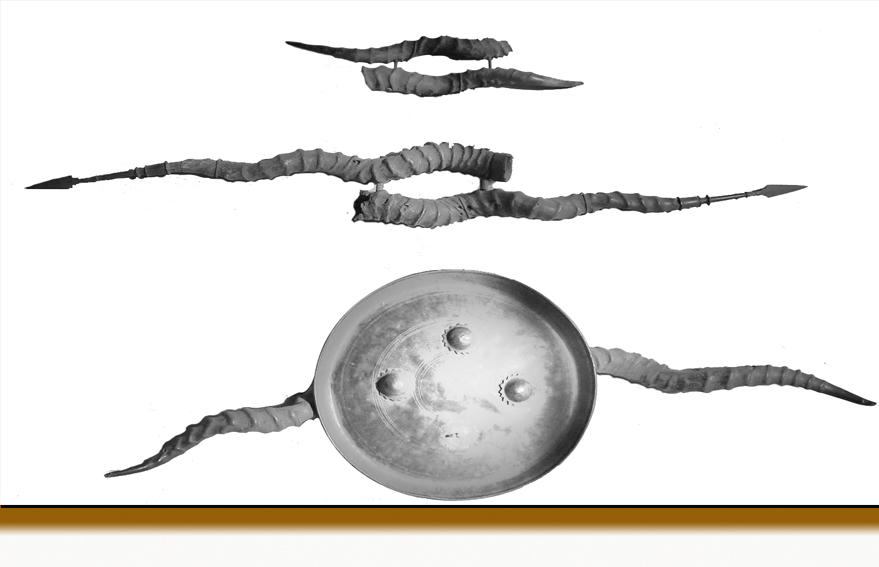

The maduvu, also known as a maru or madu

Maduvu
The maduvu, also known as a maru or madu, is a weapon from India. It is one of the many weapons used in Tamil martial arts Silambam.
Most commonly called madu, it is also referred to as maan kombu after the deer horns from which it is made, specifically from Indian Blackbuck Antilope cerviapra, also known as the Indian antelope. It is treated like a double-bladed dagger. The weapon typically consists of two blackbuck horns pointing in opposite directions connected by two crossbars which also act as a handle. Silambam experts use this weapon to confront silambam staff fencing opponents in various methods, for defensive or offensive. The fighting of Maduvu always begins with pay respect refer to Salutation of Silambam. After that, the fight of maduvu will commence. Usually, Silambam fighter will prefer to use Maduvu as defensive rather than offensive, to fight with opponents which using silambam long staff fencing and short staff fencing.
Later variations were often tipped with steel and sometimes fitted with a plate of leather or steel to act as a shield. In Punjab, the maru was typically constructed entirely of steel. A similar weapon, consisting of a handle mounted on an antelope horn, was used as a crutch and served as a self-defense implement for the jogi who were forbidden by their order to carry conventional weaponry.
- Technique
The maru is a primarily defensive weapon favouring a low stance, in which the wielder strives to stay lower than the opponent thereby reducing any openings to the body’s vital points. Typically, the maru-wielder will block or parry attacks before countering with a thrust, choke, lock or disarm. Offensively the maru is treated similarly to a dagger, used for stabbing
- Positioning
The grounding method is the favourite choice of maduvu fighter, whereby maduvu holding person will try to make himself lower than the opponent to reduce the space of attack and to reduce the body from exposure to simultaneous attacks.
- Stances
Various stances and routines based on animal movements such as the frog leap, snake, mouse, tiger, elephant, and eagle forms were used in the battle of Maduvu.
- Foot Work
Similar to footwork used in Silambam and Kalari fighting styles. Kaladi Varisai is performed with house building method which much described in Silambam footwork.
- Maduvu Sala-Varisai
Various Pattern or Kata of Deer Horn was evolved with different styles in a different state in India. Original Maan Kombu or Maduvu Sala-Varisai is also known as the advance form of pattern in Indian martial arts, which mostly practiced by black belt experts. The beginning of this lesson will take place upon graduation which followed by traditional rituals in the temple known as “Arrangetram”. After this graduation ceremony, the Instructor Guru / Aasan will then teach his student as further studies in the Advance form of Silambam Martial Arts.
- Fighting Skills
Usually, maduvu fighter will use this weapon in a close combat situation, whereby his opponent attacks by using a long blade knife or sword, silambam long staff fencing and sedi kuchi or muchchaan short staff fencing. Performing this maduvu skills in front live audience usually will start with maduvu fighter receive simultaneous attacks this is to show his skills of close combat bravery, accuracy of defensive skills and agility to evade the attacks and finally end the fight with choke, lock or disarm the opponent or his weapon with sudden strikes at proximity of offensive range. Usually, maduvu fighter needs to have great accuracy, good timing sense and cautious upon ending his final move to prevent his opponent from evading.
Reference:
https://en.my-greenday.de/7347511/1/maduvu.html